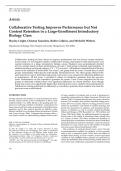Exam (elaborations)
Collaborative Testing Improves Performance but Not Content Retention in a Large-Enrollment Introductory Biology Class
- Course
- Institution
Collaborative Testing Improves Performance but Not Content Retention in a Large-Enrollment Introductory Biology Class Hayley Leight, Cheston Saunders, Robin Calkins, and Michelle Withers Department of Biology, West Virginia University, Morgantown, WV 26506 Submitted April 16, 2012; Revise...
[Show more]



